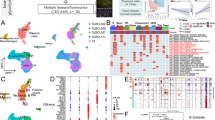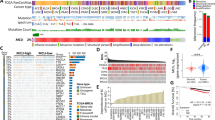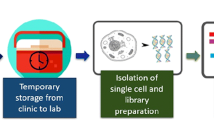Abstract
Background
Breast cancer (BC) exhibits remarkable heterogeneity. However, the transcriptomic heterogeneity of BC at the single-cell level has not been fully elucidated.
Methods
We acquired BC samples from 14 patients. Single-cell RNA sequencing (scRNA-seq), bioinformatic analyses, along with immunohistochemistry (IHC) and immunofluorescence (IF) assays were carried out.
Results
According to the scRNA-seq results, 10 different cell types were identified. We found that Cancer-Associated Fibroblasts (CAFs) exhibited distinct biological functions and may promote resistance to therapy. Metabolic analysis of tumor cells revealed heterogeneity in glycolysis, gluconeogenesis, and fatty acid synthetase reprogramming, which led to chemotherapy resistance. Furthermore, patients with multiple metastases and progression were predicted to benefit from immunotherapy based on a heterogeneity analysis of T cells and tumor cells.
Conclusions
Our findings provide a comprehensive understanding of the heterogeneity of BC, provide comprehensive insight into the correlation between cancer metabolism and chemotherapy resistance, and enable the prediction of immunotherapy responses based on T-cell heterogeneity.






Similar content being viewed by others
Data availability
The authors declare that there are no primary datasets or computer codes associated with this study. All the data and materials are available to the researchers once published.
References
Sung H, Ferlay J, Siegel RL et al (2021) Global Cancer Statistics 2020: GLOBOCAN Estimates of Incidence and Mortality Worldwide for 36 Cancers in 185 Countries. CA Cancer J Clin 71(3):209–249
Koren S, Bentires-Alj M (2015) Breast Tumor Heterogeneity: Source of Fitness. Hurdle for Therapy Mol Cell 60(4):537–546
Raghavan S, Winter PS, Navia AW et al (2021) Microenvironment drives cell state, plasticity, and drug response in pancreatic cancer. Cell 184(25):6119-6137.e26
Sathe A, Grimes SM, Lau BT et al (2020) Single-Cell Genomic Characterization Reveals the Cellular Reprogramming of the Gastric Tumor Microenvironment. Clin Cancer Res 26(11):2640–2653
Mehraj U, Dar AH, Wani NA et al (2021) Tumor microenvironment promotes breast cancer chemoresistance. Cancer Chemother Pharmacol 87(2):147–158
Marusyk A, Janiszewska M, Polyak K (2020) Intratumor heterogeneity: the Rosetta stone of therapy resistance. Cancer Cell 37:471–484
Gong Y, Ji P, Yang YS et al (2021) Metabolic-Pathway-Based Subtyping of Triple-Negative Breast Cancer Reveals Potential Therapeutic Targets. Cell Metab 33(1):51-64.e9
Azizi E, Carr AJ, Plitas G et al (2018) Single-Cell Map of Diverse Immune Phenotypes in the Breast Tumor Microenvironment. Cell 174(5):1293-1308.e36
Kim C, Gao R, Sei E et al (2018) Chemoresistance Evolution in Triple-Negative Breast Cancer Delineated by Single-Cell Sequencing. Cell 173(4):879-893.e13
Ma L, Zheng LH, Zhang DG, Fan ZM (2020) CHCHD2 decreases docetaxel sensitivity in breast cancer via activating MMP2. Eur Rev Med Pharmacol Sci 24(11):6426–6433
Garner RC (1998) The role of DNA adducts in chemical carcinogenesis. Mutat Res 402(1–2):67–75
Ladanyi A, Mukherjee A, Kenny HA et al (2018) Adipocyte-induced CD36 expression drives ovarian cancer progression and metastasis. Oncogene 37(17):2285–2301
Xu K, Wang R, Xie H et al (2021) Single-cell RNA sequencing reveals cell heterogeneity and transcriptome profile of breast cancer lymph node metastasis. Oncogenesis 10(10):66
Huang K, Zeng Y, Xie Y et al (2019) Bioinformatics analysis of the prognostic value of CCT6A and associated signalling pathways in breast cancer. Mol Med Rep 19(5):4344–4352
Shi Y, Zhao Y, Zhang Y et al (2018) AFF3 upregulation mediates tamoxifen resistance in breast cancers. J Exp Clin Cancer Res 37(1):254
Zhang J, Hu S, Li Y (2019) KRT18 is correlated with the malignant status and acts as an oncogene in colorectal cancer. Biosci Rep.39(8):BSR20190884.
Tong J, Mou S, Xiong L et al (2018) Adipose-derived mesenchymal stem cells formed acinar-like structure when stimulated with breast epithelial cells in three-dimensional culture. PLoS ONE 13(10):e0204077
Yu TJ, Ma D, Liu YY et al (2021) Bulk and single-cell transcriptome profiling reveal the metabolic heterogeneity in human breast cancers. Mol Ther 29(7):2350–2365
Currie E, Schulze A, Zechner R et al (2013) Cellular fatty acid metabolism and cancer. Cell Metab 18(2):153–161
Grasmann G, Smolle E, Olschewski H, Leithner K (2019) Gluconeogenesis in cancer cells – Repurposing of a starvation-induced metabolic pathway? Biochimica et Biophysica Acta (BBA) - Reviews on Cancer 1872:24–36. https://doi.org/10.1016/j.bbcan.2019.05.006
Waks AG, Winer EP (2019) Breast Cancer Treatment: A Review. JAMA 321(3):288–300
Bacci M, Lorito N, Smiriglia A et al (2021) Fat and Furious: Lipid Metabolism in Antitumoral Therapy Response and Resistance. Trends Cancer 7(3):198–213
Zhang J, Xiao C, Feng Z et al (2020) SOX4 promotes the growth and metastasis of breast cancer. Cancer Cell Int 20:468
Spel L, Schiepers A, Boes M (2018) NFκB and MHC-1 Interplay in Neuroblastoma and Immunotherapy. Trends Cancer 4(11):715–717
Davidson HW, Reid PA, Lanzavecchia A et al (1991) Processed antigen binds to newly synthesized MHC class II molecules in antigen-specific B lymphocytes. Cell 67(1):105–116
Henderson NC, Rieder F, Wynn TA (2020) Fibrosis: from mechanisms to medicines. Nature 587(7835):555–566
Kalluri R (2016) The biology and function of fibroblasts in cancer. Nat Rev Cancer 16(9):582–598
Delassus GS, Cho H, Park J et al (2008) New pathway links from cancer-progression determinants to gene expression of matrix metalloproteinases in breast cancer cells. J Cell Physiol 217(3):739–744
Pradhan RN, Krishnamurty AT, Fletcher AL et al (2021) A bird’s eye view of fibroblast heterogeneity: A pan-disease, pan-cancer perspective. Immunol Rev 302:299–320. https://doi.org/10.1111/imr.12990
Busch S, Andersson D, Bom E et al (2017) Cellular organization and molecular differentiation model of breast cancer-associated fibroblasts. Mol Cancer 16:73. https://doi.org/10.1186/s12943-017-0642-7
Oikari S, Kettunen T, Tiainen S et al (2018) UDP-sugar accumulation drives hyaluronan synthesis in breast cancer. Matrix Biol 67:63–74
Carmeliet P, Dor Y, Herbert JM et al (1998) Role of HIF-1alpha in hypoxia-mediated apoptosis, cell proliferation and tumour angiogenesis [published correction appears in Nature 1998 Oct 1;395(6701):525. Keshet E [corrected to Keshert E]]. Nature. 394(6692):485–490.
Vervoort SJ, Lourenço AR, Tufegdzic Vidakovic A et al (2018) SOX4 can redirect TGF-β-mediated SMAD3-transcriptional output in a context-dependent manner to promote tumorigenesis. Nucleic Acids Res 46(18):9578–9590
Li W, Zhang Z, Liu X et al (2017) The FOXN3-NEAT1-SIN3A repressor complex promotes progression of hormonally responsive breast cancer. J Clin Invest 127(9):3421–3440
Li L, Wang N, Xiong Y et al (2022) Transcription Factor FOSL1 Enhances Drug Resistance of Breast Cancer through DUSP7-Mediated Dephosphorylation of PEA15. Mol Cancer Res 20(4):515–526
Zheng X, Liu Z, Mi M et al (2021) Disulfiram Improves the Anti-PD-1 Therapy Efficacy by Regulating PD-L1 Expression via Epigenetically Reactivation of IRF7 in Triple Negative Breast Cancer. Front Oncol 11:734853
Budimir N, Thomas GD, Dolina JS et al (2022) Reversing T-cell Exhaustion in Cancer: Lessons Learned from PD-1/PD-L1 Immune Checkpoint Blockade. Cancer Immunol Res 10(2):146–153
Fu D, Li J, Wei J et al (2018) HMGB2 is associated with malignancy and regulates Warburg effect by targeting LDHB and FBP1 in breast cancer. Cell Commun Signal 16(1):8
Wutschka J, Kast B, Sator-Schmitt M et al (2021) JUNB suppresses distant metastasis by influencing the initial metastatic stage. Clin Exp Metastasis 38(4):411–423
Zhang Y, Chen H, Mo H et al (2021) Single-cell analyses reveal key immune cell subsets associated with response to PD-L1 blockade in triple-negative breast cancer. Cancer Cell 39(12):1578-1593.e8
Pal B, Chen Y, Vaillant F et al (2021) A single-cell RNA expression atlas of normal, preneoplastic and tumorigenic states in the human breast. EMBO J. 40(11):e107333
Zhou Y, Yang D, Yang Q et al (2020) Single-cell RNA landscape of intratumoral heterogeneity and immunosuppressive microenvironment in advanced osteosarcoma [published correction appears in Nat Commun. 2021 Apr 30;12(1):2567]. Nat Commun. 11(1):6322
Meacham CE, Morrison SJ (2013) Tumour heterogeneity and cancer cell plasticity. Nature 501(7467):328–337
Sato F, Saji S, Toi M (2016) Genomic tumor evolution of breast cancer. Breast Cancer 23(1):4–11
Savas P, Virassamy B, Ye C et al (2018) Single-cell profiling of breast cancer T cells reveals a tissue-resident memory subset associated with improved prognosis [published correction appears in Nat Med. 2018 Dec;24(12):1941]. Nat Med. 24(7):986-993
Peng J, Sun BF, Chen CY et al (2019) Single-cell RNA-seq highlights intra-tumoral heterogeneity and malignant progression in pancreatic ductal adenocarcinoma [published correction appears in Cell Res. 2019 Aug 13;:]. Cell Res. 29(9):725-738
Liang Y, Zhang H, Song X et al (2020) Metastatic heterogeneity of breast cancer: Molecular mechanism and potential therapeutic targets. Semin Cancer Biol 60:14–27
Xiao Y, Ma D, Yang YS et al (2022) Comprehensive metabolomics expands precision medicine for triple-negative breast cancer. Cell Res 32(5):477–490
Gradishar WJ, Anderson BO, Abraham J et al (2020) Breast Cancer, Version 3.2020, NCCN Clinical Practice Guidelines in Oncology. J Natl Compr Canc Netw. 18(4):452–478.
Wapnir IL, Khan A (2019) Current Strategies for the Management of Locoregional Breast Cancer Recurrence. Oncology (Williston Park).33(1):19–25.
Izar B, Tirosh I, Stover EH et al (2020) A single-cell landscape of high-grade serous ovarian cancer. Nat Med 26(8):1271–1279
Ren J, Smid M, Iaria J et al (2019) Cancer-associated fibroblast-derived Gremlin 1 promotes breast cancer progression. Breast Cancer Res 21(1):109
Miles D, Gligorov J, André F et al (2021) Primary results from IMpassion131, a double-blind, placebo-controlled, randomised phase III trial of first-line paclitaxel with or without atezolizumab for unresectable locally advanced/metastatic triple-negative breast cancer. Ann Oncol 32(8):994–1004
Lomakin A, Svedlund J, Strell C et al (2022) Spatial genomics maps the structure, nature and evolution of cancer clones. Nature 611(7936):594–602
Osmanbeyoglu, Hatice U et al. (2014) Linking signaling pathways to transcriptional programs in breast cancer. Genome Research vol. 24,11: 1869–80
Correia L et al. (2022) Allelic expression imbalance of PIK3CA mutations is frequent in breast cancer and prognostically significant. NPJ breast cancer vol. 8, 1 71. 8
Mouron S et al. (2021) FGFR1 amplification or overexpression and hormonal resistance in luminal breast cancer: rationale for a triple blockade of ER, CDK4/6, and FGFR1. Breast Cancer Research: BCR vol. 23,1 21. 12
Acknowledgements
We thank the breast cancer patients from Yunnan Cancer Hospital who participated in this study and acknowledge the contributions to this study of the entire research team.
Funding
The present study was supported by the National Natural Science Foundation of China (grant no. 81960542, 81960517, 82260575, 82360345, and 82360614), the Science and Technology Project of Yunnan Provincial Science and Technology Department (grant no. 202001AU070053, 202001AU070093,202201AY070001-169, and 202401AT070005), the Yunnan Health Training Project of High Level Talents (grant no. H-2019075), the Natural Science Foundation of Yunnan Province (subtitle: major basic research project) (grant no. 202001BC070001, 202102AA100053), the Beijing Science and Technology Innovation Medical Development Foundation (grant no. KC2021-JK-0044–6), the Scientific Research Foundation of the Education Department of Yunnan Province (grant no. 2024J0261), Kunming Medical Joint Special Project - Major Project (grant no. 202401AY070001-042), and Kunming Medical Joint Special Project - General Project (grant no. 202401AY070001-268), and the Yunnan Provincial Department of Education Scientific Research Fund Project (grant no.2024Y237). Wu Jieping Medical Foundation Tumor Targeted Research Special Fund, Grand Number: 320.6750.2021-10-73.
Author information
Authors and Affiliations
Contributions
SCT, RRY, CK and RG conceived the project and revised the manuscript. QW, KS, RL, XT, HML, YFL, FYY, SJL, PPB, JLY and YS performed the experiments. QW, ZNZ,JWZ and DWJ analyzed the data. DC, ZRC and XML assessed the tumor blood supply before sample collection. ZXH, LY, ZHL and TFK diagnosed BC and performed the experiments. RL and KZ collected patient data.
Corresponding authors
Ethics declarations
Ethics approval and consent to participate
This study involved human participants and was approved by the Ethics Committee of Yunnan Cancer Hospital (No. KY201944). Prior to participation, subjects provided informed consent to participate in the investigation.
Consent for publication
All the authors have approved the manuscript for submission.
Competing interests
All the authors declare no competing interests.
Additional information
Publisher's Note
Springer Nature remains neutral with regard to jurisdictional claims in published maps and institutional affiliations.
Supplementary Information
Below is the link to the electronic supplementary material.
Supplementary
Figure S1 Functional status analysis of BC malignant epithelial cells. (A) Heatmap depicting the genes highly expressed in the BC malignant epithelial cell subclusters. (B) GO enrichment pathway analysis of malignant epithelial cell subsets. (C) KEGG enrichment pathway analysis of malignant epithelial cell subsets. (D) Overall survival Kaplan‒Meier curves for BC patients with high and low CD74, FDCSP and KRT81 expression levels. (TIF 11211 kb)
Supplementary Figure S2
Effect of metabolic heterogeneity on chemotherapy response. (A) IHC analysis of key enzymes involved in the TCA cycle, glycolysis, and fatty acid synthesis in patients exhibiting resistance to neoadjuvant chemotherapy. (B) IHC analysis of key enzymes involved in the TCA cycle, glycolysis, and fatty acid synthesis in patients with a favorable response to neoadjuvant chemotherapy. (TIF 23146 kb)
Supplementary Figure S3
Outgoing and incoming communication patterns between tumor cells and immune cells. (TIFF 4834 kb)
Supplementary Figure S4
Functional status analysis of CAFs. (A) tSNE diagram showing the distribution of CAFs in various types of BC tissues and normal tissues. (B) Proportions of CAF subsets in the classification of BC and normal tissues. (C) Hallmark enrichment pathway analysis of CAF subsets. (TIF 3684 kb)
Supplementary Figure S5
Functional status analysis of T cells. (A) t-SNE diagram showing the distribution of T cells in various types of BC and normal tissues. (B) Proportions of T-cell subsets in the classification of BC tissues and normal tissues. (C) Dot plot showing the immune checkpoint genes of the T-cell subclusters. (D) GO enrichment pathway analysis of T-cell subsets. (E) KEGG enrichment pathway analysis of T-cell subsets. (F) Violin plot displaying the expression levels of various marker genes in ten T-cell clusters. (TIF 9643 kb)
Supplementary Figure S6
Trajectory analysis of T cells. (A) Development path of T cells associated with monocle2. (B) Heatmap depicting the relative expression of T-cell markers along the estimated route. (C) Trajectory analysis of 10 subclusters of T cells. (TIF 4485 kb)
Supplementary Figure S7
Expression levels of different BC subtypes. (A) Circos maps depicting the functional enrichment results of tumor epithelial cells in TNBC patients. (B) Circos maps depicting the functional enrichment results of tumor epithelial cells in HER2+ BC patients. (C) Circos maps depicting the functional enrichment results of tumor epithelial cells in luminal BC patients. (D) Circos maps depicting the functional enrichment results of tumor epithelial cells in TNBC patients in the BC cohort (GSE176078). (E) Circos maps depicting the functional enrichment results of tumor epithelial cells in HER2+ BC patients in the BC cohort (GSE176078). (F) Circos maps depicting the functional enrichment results of tumor epithelial cells in luminal BC patients in the BC cohort (GSE176078). (G) Heatmap of average metabolic gene expression levels in the TCA cycle, glycolysis and gluconeogenesis, and fatty acid biosynthesis in different types of BC. (TIF 46649 kb)
Rights and permissions
Springer Nature or its licensor (e.g. a society or other partner) holds exclusive rights to this article under a publishing agreement with the author(s) or other rightsholder(s); author self-archiving of the accepted manuscript version of this article is solely governed by the terms of such publishing agreement and applicable law.
About this article
Cite this article
Tang, S., Wang, Q., Sun, K. et al. Metabolic Heterogeneity and Potential Immunotherapeutic Responses Revealed by Single-Cell Transcriptomics of Breast Cancer. Apoptosis 29, 1466–1482 (2024). https://doi.org/10.1007/s10495-024-01952-7
Accepted:
Published:
Issue Date:
DOI: https://doi.org/10.1007/s10495-024-01952-7




